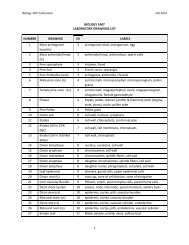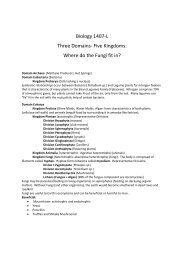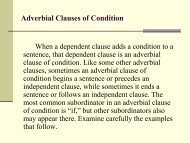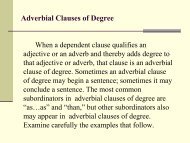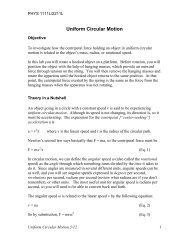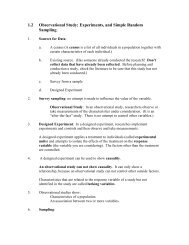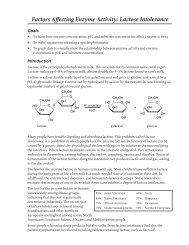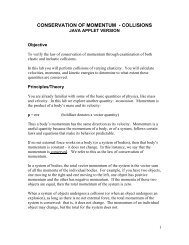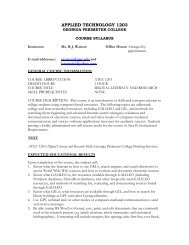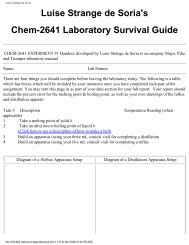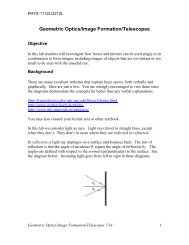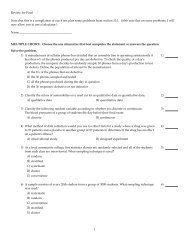You also want an ePaper? Increase the reach of your titles
YUMPU automatically turns print PDFs into web optimized ePapers that Google loves.
PHYS 1112L/2212L<br />
Kirchhoff’s <strong>Laws</strong><br />
Objective<br />
To practice setting up and measuring complex circuits and to practice solving<br />
circuits using Kirchhoff’s <strong>Laws</strong>.<br />
Theory in a Nutshell<br />
Sometimes you may be faced with complex circuits with multiple loops and<br />
numerous junctions. In order to find the current in various parts of the circuit, you<br />
can use Kirchhoff’s <strong>Laws</strong>, which can be stated simply this way:<br />
• The amount of current coming into a junction equals the amount of current<br />
going out of it. That is, there are no sources or sinks of current; it does not<br />
magically appear or disappear.<br />
• In going around a closed loop of a circuit, the sum of voltage changes must<br />
equal zero. That is, if you gain any voltage going across some component in a<br />
circuit, that must be offset by an equal loss somewhere else in the loop.<br />
Let us consider an example of how to apply these rules. See the circuit below.<br />
You have a DC power supply and a parallel combination of resistors R 1 and R 2 ,<br />
with currents through them equal to I 1 and I 2 , respectively. Total current I comes<br />
out of the power supply on the left and flows clockwise until it reaches the<br />
junction at the top of the circuit. We can visualize this circuit as follows:<br />
The total current I comes in from the left and splits into two branches, I 1 and I 2 .<br />
Kirchhoff’s junction rule tells us that I = I 1 + I 2 . You can draw the currents in<br />
Kirchhoff’s <strong>Laws</strong> 5/13 1
PHYS 1112L/2212L<br />
either direction. Be bold! The worst that can happen (assuming you do your<br />
calculations correctly) is that you will get a negative number for your current.<br />
That just means it goes opposite the direction you drew it. Take a deep breath,<br />
decide which direction each current must go, and write your equations for each<br />
junction.<br />
Now consider the closed loop consisting of the power supply and R 1 . We can<br />
think of it this way:<br />
Remember this is just one loop of the circuit. We drew the current going<br />
clockwise. Start at the lower left corner (you can start anywhere, but lower left<br />
seems like a convenient place to start).<br />
We cross the power supply from negative to positive (remember the longer line<br />
denotes the positive side of the DC supply). That means we add voltage in the<br />
amount the power supply is putting out. So we have +V. Now we continue on<br />
around the circuit, going through only wire until we reach R 1 . While we are just<br />
going through wire, these are ideal wires, so there is no resistance and no loss of<br />
voltage. So now we get to R 1 . Since we are going in the direction of the current,<br />
there is a voltage drop across the resistor, given by Ohm’s law as the product of<br />
the current and the resistance. So we have –I 1 R 1 for the change in voltage.<br />
Now we are at the bottom of the loop and there is just more wire back to the<br />
starting place, so no gain or loss of voltage. We can write Kirchhoff’s loop rule<br />
for this loop as follows: +V – I 1 R 1 = 0.<br />
If we went the other way around the circuit, the signs would change. If we went<br />
from positive to negative across the DC supply, the voltage change would be –V.<br />
If we went across the resistor opposite to the direction of the current, the voltage<br />
change would be +I 1 R 1 . In either case, you wind up with V = I 1 R 1 . You can<br />
repeat this process for the outside loop of the circuit.<br />
When solving these circuits, decide which direction you believe the currents go,<br />
and draw them. Then write the equation for each junction, where the current<br />
coming in equals the current coming out. Then look at each loop and write an<br />
equation for the loop rule. That should give you enough equations to solve even<br />
the most complex circuit. And of course, be careful with your algebra.<br />
Kirchhoff’s <strong>Laws</strong> 5/13 2
PHYS 1112L/2212L<br />
Worked Example (review thoroughly before coming to lab)<br />
Let’s work an example with numbers. Consider the circuit below. The emf is 6<br />
volts. R 1 = 100 ohms, and R 2 = R 3 = 50 ohms. What is the current through each<br />
resistor<br />
We notice that the current that flows through the emf (let’s call it I 1 ) flows around<br />
to the junction at a, and then splits into two parts (call them I 2 and I 3 ). They flow<br />
down through their respective resistors and then rejoin at junction b. The<br />
combined current (I 1 ) flows through R 1 and then back through the emf.<br />
From the junction rule, you can write I 1 = I 2 + I 3 . That’s one equation. We need<br />
two more.<br />
Consider the loop that runs through the emf, around through a, down through R 2 ,<br />
through b, then through R 1 . The sum of voltage gains and drops must equal zero.<br />
If we begin at the lower left corner of the circuit, and work clockwise, first we<br />
pass through the emf from negative to positive. This adds 6 V. Then we move<br />
along until we get to R 2 . We drew the current I 2 going down, so the voltage will<br />
drop by an amount equal to I 2 R 2 . Now we move through R 1 , and again, since we<br />
drew the current going to the left, the voltage will drop by I 1 R 1 . So the equation<br />
reads:<br />
+6 V – I 2 R 2 – I 1 R 1 = 0<br />
That’s two equations. We need one more.<br />
Consider the loop that runs through the emf, around through a, down through R 3 ,<br />
through b, then through R 1 . The sum of voltage gains and drops must equal zero.<br />
If we begin at the lower left corner of the circuit, and work clockwise, first we<br />
pass through the emf from negative to positive. This adds 6 V. Then we move<br />
along until we get to R 3 . We drew the current I 3 going down, so the voltage will<br />
Kirchhoff’s <strong>Laws</strong> 5/13 3
PHYS 1112L/2212L<br />
drop by an amount equal to I 3 R 3 . Now we move through R 1 , and again, since we<br />
drew the current going to the left, the voltage will drop by I 1 R 1 . So the equation<br />
reads:<br />
+6 V – I 3 R 3 – I 1 R 1 = 0<br />
That’s three equations in three unknowns. You can solve it any way that makes<br />
sense to you, but here’s one way. Subtract the two loop equations.<br />
+6 V – I 2 R 2 – I 1 R 1 = 0<br />
+6 V – I 3 R 3 – I 1 R 1 = 0<br />
0 V - I 2 R 2 – (-I 3 R 3 ) – I 1 R 1 – (-I 1 R 1 ) = 0<br />
-I 2 R 2 + I 3 R 3 = 0 so I 2 R 2 = I 3 R 3<br />
Now, since in this case, R 2 = R 3 , you can also say that I 2 = I 3 .<br />
Back to the junction rule, I 1 = I 2 + I 3 . Since I 2 = I 3 , then I 1 = 2I 2 .<br />
Go back to the first loop equation and rewrite in terms of I 2 .<br />
+6 V – I 2 R 2 – 2I 2 R 1 = 0<br />
Substitute in the values of R 1 and R 2 that you were given in the problem.<br />
+6 – I 2 (50) – 2I 2 (100) = 0<br />
Simplify: +6 – 50I 2 – 200I 2 = +6 – 250I 2 = 0<br />
+6 = 250I 2 I 2 = 6/250, or 0.024 amp = I 3<br />
I 1 = 2I 2 = 0.048 amp<br />
Are those correct How would we check One way is to review the circuit. With<br />
your extensive knowledge of series and parallel circuits, you could calculate the<br />
net resistance in the circuit. 100 ohms in series with a parallel combination of two<br />
50 ohms equals 100 plus 1/(1/50 + 1/50) = 100 + 25 = 125Ω. So the current<br />
flowing through the emf = I 1 = 6V/125Ω = 0.048A. And since R 2 = R 3 , then I 2 =<br />
I 3 , so each must be one-half of 0.048, or 0.024. Bingo.<br />
Kirchhoff’s <strong>Laws</strong> 5/13 4
PHYS 1112L/2212L<br />
You should attempt to solve each of the circuits below before coming to lab class.<br />
Follow the same general procedure:<br />
• Identify all junctions.<br />
• Label all emfs, resistors, and currents. Use subscripts wisely to keep<br />
everything straight.<br />
• Decide and draw how you think the current will flow in each part of the<br />
circuit.<br />
• Write the junction rule equation for each junction.<br />
• Write the loop rule equation for each loop.<br />
• Do the best algebra you have ever done in your life.<br />
Equipment<br />
Power supplies<br />
Resistors<br />
Multimeters<br />
Wires, clips, etc.<br />
Procedure<br />
In this lab you will do three circuits. In each case, before you set up the circuit,<br />
calculate the current in each loop using Kirchhoff’s <strong>Laws</strong> (this is sometimes called<br />
solving the circuit). Then set up the circuit and measure each current. If you get a<br />
substantial difference, you have an issue either with your calculations or with your<br />
circuit; work at it until you resolve the issue. Show all work to receive credit for<br />
this lab. Note whether currents are positive or negative, and explain why.<br />
Kirchhoff’s <strong>Laws</strong> 5/13 5
PHYS 1112L/2212L<br />
Circuit #1 – one emf<br />
R 1 = 2000 Ω<br />
R 2 = R 4 = 1000 Ω<br />
R 3 = 1500 Ω<br />
Once you have solved the circuit, set it up and measure the current in each loop.<br />
Calculate percent errors for your measured values.<br />
Circuit #2 – two emfs<br />
R 1 = 1000 Ω<br />
R 2 = 2000 Ω<br />
R 3 = 3000 Ω<br />
Once you have solved the circuit, set it up and measure the current in each loop.<br />
Pay particular attention to positive and negative values, and explain each.<br />
Calculate percent errors for your measured values.<br />
Kirchhoff’s <strong>Laws</strong> 5/13 6
PHYS 1112L/2212L<br />
Circuit #3 = three emfs<br />
ε 1 = 8 V<br />
ε 2 = ε 3 = 4 V<br />
R 1 = 1000 Ω<br />
R 2 = 2000 Ω<br />
R 3 = 6000 Ω<br />
Once you have solved the circuit, set it up and measure the current in each loop.<br />
Pay particular attention to positive and negative values, and explain each.<br />
Calculate percent errors for your measured values.<br />
Kirchhoff’s <strong>Laws</strong> 5/13 7
PHYS 1112L/2212L<br />
Questions<br />
1. Kirchhoff’s laws – the loop rule and the junction rule – are each based on a<br />
fundamental conservation principle in physics. For each rule, explain in your own<br />
words what conservation principle is involved and how it leads logically to the<br />
rule.<br />
2. Are your measured currents generally larger or smaller than the theoretical<br />
values you calculated<br />
3. We have done this lab assuming negligible resistance for these three things:<br />
• The power supply<br />
• The ammeter<br />
• The wires<br />
If any or all of these have non-negligible resistance, explain qualitatively<br />
how that might affect your measured currents. Would each of these make<br />
the current larger, or smaller<br />
4. Extra credit: find a documented estimate (such as from the manufacturer)<br />
for the resistances of the three components listed above, and show quantitatively<br />
how large an error, if any, such resistances would cause in your results. Your<br />
instructor will provide you the information on where the components are<br />
purchased if you need that. Show all work.<br />
Kirchhoff’s <strong>Laws</strong> 5/13 8



